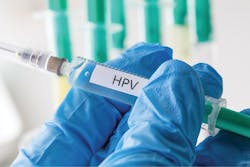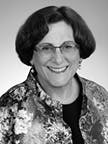Patient Relations
Talking about HPV vaccination can prevent cancer and save lives
By JoAnn Gurenlian, RDH, PhD
This summer, CBS News aired a story by Tara Narula, MD, concerning human papillomavirus (HPV) vaccines that was picked up by the print media. Dr. Narula championed the need for the public and health-care providers to be more aggressive about addressing the public health crisis associated with HPV.1
According to the Centers for Disease Control and Prevention (CDC), it is estimated that 79 million individuals in the US are infected with genital HPV, and 14 million people become newly infected each year. Most of these individuals are teens and young adults. HPV is the most common sexually transmitted infection; almost everyone will acquire an HPV infection at some point in life. Most HPV infections are asymptomatic and resolve spontaneously, but some persist and become cancerous. Every year, approximately 19,200 women and 11,600 men are diagnosed with an HPV-related cancer—cervical, vaginal, penile, anal, or oropharyngeal.2
The good news is that there is a vaccine for HPV that can prevent many of these HPV-related cancers. The bad news is that many young people are not getting the vaccine. Of all the vaccines available for children, the HPV vaccine is the most underutilized.
So, if we have this knowledge and a powerful tool—HPV vaccination—to prevent both oropharyngeal and genital cancers, why aren’t we talking about it? ... HPV is our territory. There are no borders ... no lines in the sand to hide behind.
Currently, three HPV vaccines are licensed by the Food and Drug Administration: (1) bivalent/2v HPV vaccine (Cervarix) protects against HPV types 16 and 18; (2) quadrivalent/4v HPV vaccine (Gardasil) protects against HPV types 6, 11, 16, and 18; and (3) 9-valent/9v HPV vaccine (Gardasil 9) protects against HPV types 6, 11, 16, 18, 31, 33, 45, 52, and 58. The additional five types in the 9-valent HPV vaccine mostly benefit the HPV-associated cancers that occur in women.
Vaccination is routinely recommended for adolescents at age 11 or 12, but can begin for boys and girls as early as age nine. The CDC recommends vaccination for females ages 13 to 26 and males ages 13 to 21 if they have not been adequately vaccinated previously.2 A two-dose schedule is used for adolescents beginning vaccination at ages nine to 14. For those ages nine to 14 who have already received two doses of the vaccine less than five months apart, a third dose is recommended. For those teens and older individuals who start the series at ages 15 to 26, a three-dose schedule is recommended. The CDC offers health-care practitioners a decision tree to assist in learning dose regimens that is available at cdc.gov.3
So, if we have this knowledge and a powerful tool—HPV vaccination—to prevent both oropharyngeal and genital cancers, why aren’t we talking about it? As Dr. Narula reported in her television segment, other countries such as Canada, Australia, and the United Kingdom have doubled their vaccination rates compared to the US. There appears to be a reticence among our health-care providers to be proactive and aggressive in recommending vaccination.
In response, the CDC is working to get the message across that the HPV vaccine prevents cancer, saves lives, and is safe. Perhaps you have seen the powerful commercial: “Did you know? Mom? Dad?” More recently, the Maryland Department of Health issued a letter to all health-care providers, including licensed dental professionals, asking them to help address the critical public health issue of undervaccination of Maryland’s adolescents against HPV. The letter encouraged physicians, dental hygienists, dentists, local health departments, and parents to do their part to increase HPV vaccination coverage in the state.
Further, the CDC offers a question-and-answer sheet titled, “Talking to Parents about HPV Vaccine” available at its website.4 This tip sheet addresses typical parental concerns such as: Why vaccinate? Is my child at risk? Why vaccinate at such a young age? Is it safe? How do you know it works? Will vaccination make my child think it is OK to have sex?
Understandably, this is a difficult topic to read about, let alone consider talking about with patients. However, we tend to draw artificial lines in the sand and say, “I won’t go there.” “This has nothing to do with the mouth or oral health.” “This is not my territory.” But, my colleagues, HPV is our territory. There are no borders ... no lines in the sand to hide behind. I chose this topic because this is the December column, and I want you to think about giving this month. Use the resources listed here, learn about this subject, and start talking with your patients. Give the gift of a conversation that prevents cancer and saves lives. You will be glad you did. Good tidings to all!
References
1. Narula T. HPV vaccine: Why aren’t children getting it? CBS News website. https://www.cbsnews.com/news/hpv-vaccination-cancer-prevention-dr-tara-narula/. Published July 23, 2017. Accessed September 5, 2017.
2. HPV vaccine information for clinicians. U.S. Department of Health and Human Services. Centers for Disease Control and Prevention. National Center for Immunization and Respiratory Diseases. https://www.cdc.gov/hpv/hcp/need-to-know.pdf. Published December 20, 2016. Accessed September 5, 2017.
3. HPV 2 dose decision tree. Preventing cancer just got easier. U.S. Department of Health and Human Services. Centers for Disease Control and Prevention. https://www.cdc.gov/hpv/downloads/hpv-2-dose-decision-tree.pdf. Published March 2017. Accessed September 5, 2017.
4. Talking to parents about HPV vaccine. U.S. Department of Health and Human Services. Centers for Disease Control and Prevention. https://www.cdc.gov/hpv/hcp/for-hcp-tipsheet-hpv.pdf. Published December 2017. Accessed September 5, 2017.
JOANN R. GURENLIAN, RDH, PhD, is president of Gurenlian & Associates, and provides consulting services and continuing education programs to health-care providers. She is a professor and dental hygiene graduate program director at Idaho State University, and past president of the International Federation of Dental Hygienists.








